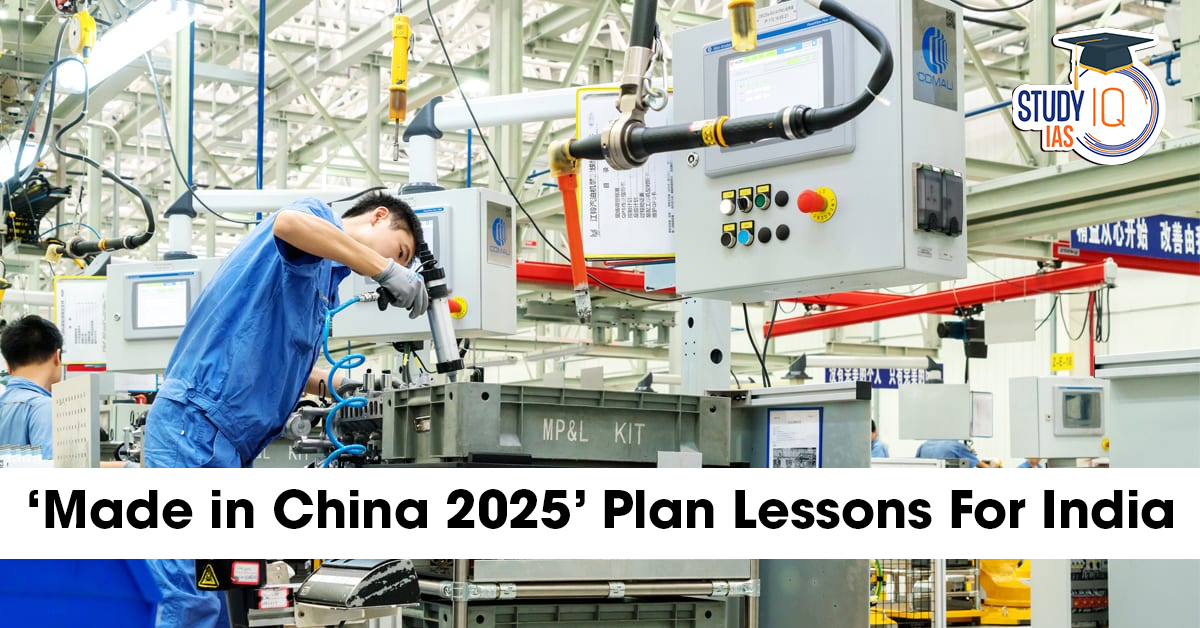Table of Contents
Context: Amid Apple’s shift from China to India for iPhone manufacturing, China’s ‘Made in China 2025’ policy and India’s ‘Make in India’ initiative offer contrasting lessons in industrial policy and global supply chains.
About Make in India Initiative
- Launch: September 2014.
- Aim: Transform India into a global manufacturing hub by boosting investment, innovation, skill development, and manufacturing infrastructure.
Key Features
- Promotes ease of doing business and FDI.
- Focuses on 25 sectors, including electronics, automobiles, defence, and textiles.
- Encourages job creation and skill enhancement.
Achievements
- Attracted significant FDI inflows.
- Growth in sectors like mobile phone assembly (e.g., Apple, Samsung).
- Supported by production-linked incentive (PLI) schemes.
About ‘Made in China 2025’
- Launch:
- Aim: Upgrade China’s manufacturing from low-cost mass production to high-tech, high-value sectors by 2025.
Core Focus Areas
- 10 sectors: Next-gen IT, high-end numerical control machinery, aerospace, new materials, biotech, green vehicles, power equipment, robotics, railways, and maritime engineering.
Approach
- Heavy state support, subsidies, and policy-driven investments.
- Focus on self-reliance, indigenous innovation, and global market dominance.
Achievements
- Global leader in electric vehicles, solar modules, and lithium-ion batteries.
- World-class high-speed rail, advanced robotics, and integrated supply chains.
What Made “Make in China 2025” Successful & Lessons for India?
- Strategic State Support: China’s aggressive, policy-backed support (loans, subsidies, tax relief) accelerated tech adoption and global competitiveness.
- Lesson: India needs a clear, sustained policy push and better coordination between central and state governments.
- Focus on High-Value Manufacturing: China moved quickly from labour-intensive goods to advanced manufacturing (AI, robotics, EVs).
- Lesson: India should target select high-tech sectors for rapid scaling, beyond low-end assembly.
- R&D and Skill Development: China invested heavily in R&D and technical workforce upskilling.
- Lesson: India must boost funding for research and technical education to build a world-class talent pool.
- Integrated Supply Chains: China created deep, integrated supply chains, reducing reliance on imports.
- Lesson: India should nurture domestic supplier ecosystems and reduce dependence on foreign intermediates.
- Balanced Growth: China’s manufacturing focus came at the expense of its services sector and domestic consumption.
- Lesson: India should pursue manufacturing growth without neglecting its strong services sector and domestic demand.
- Global Perception & Trade Practices:
- Aggressive policies led to global backlash and allegations of unfair trade practices against China.
- Lesson: India must ensure its policies are WTO-compliant and foster positive international trade relationships.
- IP and Technology Acquisition: China’s insistence on technology transfer from foreign firms accelerated local capabilities but caused friction.
- Lesson: India should encourage technology partnerships while respecting IP rights, and building trust with global investors.


 Iran Nuclear Crisis and India’s Role f...
Iran Nuclear Crisis and India’s Role f...
 H1B Visa Program, Beneficiaries, Eligibi...
H1B Visa Program, Beneficiaries, Eligibi...
 Comparison Between India & France's ...
Comparison Between India & France's ...

























